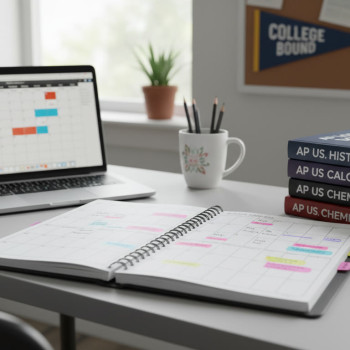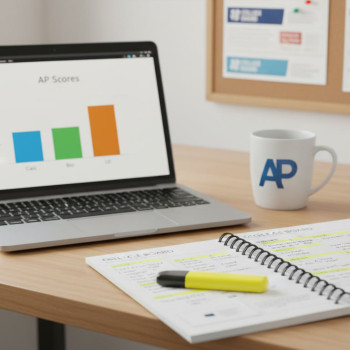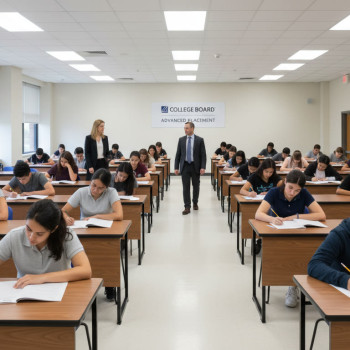Study Pods & Friends: Why Guardrails Matter for AP Success
When your teenager decides to prepare for an AP course, the energy and enthusiasm that comes from studying with friends can be a real gift. Laughter that breaks tension, friendly competition that pushes everyone, and shared resources that make review sessions more efficient — study pods can be wonderful. But without a little structure, they can also become social hangouts that leave everyone stressed the week before the exam.
This article is written for parents who want to support their child’s AP journey in a way that respects independence while adding calm, practical guardrails that increase the odds of success. You’ll find conversational guidance, real-world examples, and a few tools — including how one-on-one, personalized tutoring (like Sparkl’s tailored plans and expert tutors) can fit naturally into a balanced strategy — all without stepping on your teen’s autonomy.
What a good study pod looks like
A healthy study pod is more than a group of friends who meet to “study.” It’s a small team with clear goals, a rhythm, and shared expectations. Think of it as a tiny project team with a mission: master the AP content and do it without burning out.
- Size: 3–5 students — large enough for diverse strengths, small enough to stay focused.
- Roles: Rotate simple roles like facilitator, note-taker, problem-wrangler, and timekeeper.
- Frequency: Consistent short sessions (60–90 minutes) beat intermittent marathon weekends.
- Focus: Each session should have a clear goal (e.g., practice multiple-choice on electromagnetism; outline the next three FRQs).

Why parental guardrails are useful (and not overbearing)
Kids are building study habits that will last a lifetime. Parental guardrails serve three functions: they create safety, help translate good intentions into action, and protect time and energy for rest. Importantly, they should enable autonomy rather than replace it.
- Safety: Clear rules about location, timing, and communication reduce friction and keep everyone accountable.
- Structure: Teens often have the will but not the willpower; guardrails shape consistent studying into predictable routines.
- Balance: Guardrails help students avoid all-work-or-nothing cycles and keep social life and sleep in healthy proportions.
How to set guardrails without micromanaging
The best approach communicates trust and expects responsibility. Use curiosity and co-design rather than decrees.
- Start with a short conversation: Ask your teen what they want the study pod to accomplish, then offer the parent perspective as a collaborator.
- Negotiate rules together: availability windows, adult-supervised locations for younger teens, and a loose agenda template for each session.
- Check in weekly, not daily: A short Sunday status chat (10–15 minutes) keeps you informed without hovering.
- Design consequences that are restorative, not punitive: Missed commitments might mean shifting who facilitates next week, or a brief reflection on what went wrong and how to fix it.
Concrete guardrails to implement
Below are practical, parent-friendly guardrails you can propose and help your child implement. These are intentionally light-touch and reversible as your teen shows responsibility.
1. A simple agreement
Ask the pod to write a one-page agreement that captures the essentials: meeting times, duration, location, shared goals, basic rules (phones on silent or in a basket during timed work), and a communication plan if someone can’t make it. Having students write it themselves increases buy-in.
2. Clear meeting rhythm
Suggest a cadence like 2–3 sessions per week, 60–90 minutes each. These shorter, regular sessions beat marathon cram nights and build cumulative learning.
3. Agenda template
Provide a simple agenda they can reuse. Having a template prevents sessions from dissolving into aimless review.
- 10 minutes — quick check-in & goals
- 30–45 minutes — focused study (timed practice or targeted review)
- 10–15 minutes — share answers/teach-back
- 5–10 minutes — plan and assign next steps
4. Accountability with kindness
Encourage peer accountability: if someone repeatedly misses sessions, the pod agrees on a supportive response (private check-in, reassigning roles). Parents can model accountability by following through on agreed supports, like driving younger teens to supervised sessions.
5. Balance and wellbeing rules
Set limits that protect sleep, meals, and mental health. A few examples:
- No study pods after 9:30 PM on school nights (or earlier depending on school start times).
- One full day off each weekend with no AP work allowed.
- Rotation of social activities so the group doesn’t become purely academic or purely social.
Practical examples — sample weekly plan
Here’s a simple example of how a study pod for AP Biology or AP US History might structure one week alongside schoolwork and personalized tutoring.
| Day | Pod Activity | Individual Work | Optional Tutoring |
|---|---|---|---|
| Monday | 60-min review of last week’s practice problems | 30-min spaced practice | None |
| Wednesday | 90-min targeted FRQ practice (timed) | Teacher feedback review | 30-min Sparkl session for FRQ strategies (if needed) |
| Friday | 60-min concept teach-back (each member explains one concept) | Flashcards or problem set | Optional 1-on-1 with Sparkl tutor for personalized weak-point work |
| Sunday | Planning chat: set goals for next week | 30–45-minute self-study | Review of quiz errors with tutor (biweekly) |
This blend keeps the pod focused but allows for personalization. That personalization can include targeted one-on-one tutoring when a student needs deeper explanation — something Sparkl’s personalized tutoring model supports through tailored study plans and expert tutors who can zero in on specific AP skills.
Communication and conflict: parenting tips
Small groups sometimes run into personality clashes, unequal effort, or scheduling friction. As a parent, you don’t need to fix everything, but you can help your teen develop conflict-resolution skills.
Teach negotiation language
Give your child a few phrases to defuse tension: “I appreciate your idea — can we try it for two sessions and reassess?” or “I felt frustrated when X happened; can we agree on Y next time?” These simple scripts help them stand up for themselves without escalating.
When to step in
Step in if there’s repeated disrespect, exclusion, or if the pod’s behavior is harming grades or wellbeing. Otherwise, encourage the pod to rotate roles and try internal solutions first. If your teen asks for help, make space to listen and then coach toward a practical next step.
When to bring in extra support
Even the best study pods aren’t a substitute for targeted instruction when a student has specific gaps. Signs that one-on-one help could be valuable include:
- Steady low scores on practice exams despite consistent study.
- Difficulty with a particular type of question (e.g., FRQs vs. multiple-choice).
- Loss of confidence or increasing test anxiety.
Personalized tutoring can complement a study pod wonderfully. Brief, targeted sessions help students make breakthroughs, then bring those insights back to the group. Services like Sparkl offer tailored study plans, expert tutors, and AI-driven insights that can pinpoint weak areas and maximize the efficiency of both group and solo study time.
Tools and templates to keep things running
A few low-tech and high-impact tools make a big difference:
- Shared calendar (Google Calendar or a physical family calendar) for scheduling and visibility.
- Simple one-page pod agreement (location, cadence, roles, phone policy).
- Agenda template (see earlier) saved in a shared doc for repeat use.
- Practice-log: a one-page weekly tracker where each student records time spent, topics covered, and one action item.

Using practice tests wisely
Full-length practice exams are the single best way to build stamina and confidence, but they are time-consuming. Use past AP-style practice tests strategically:
- Schedule a full practice test every 3–4 weeks during the core prep phase.
- Use shorter, targeted practice sets weekly to address specific weak areas.
- Grade and review as a pod — one person times, another collects answers, then rotate responsibilities.
Balancing social life and seriousness
One perennial worry parents have: will study pods kill friendships? The opposite is often true. When pods have clear boundaries, study time and social time can strengthen friendships rather than strain them.
- Alternate study sessions with social mini-events (e.g., one study session followed by a 20-minute walk or snack time).
- Allow the group to schedule a monthly hangout that is intentionally not about APs.
- Encourage honesty about stress: normalizing “I need a break” is healthy and sustainable.
Measuring progress — pragmatic metrics
Parents want to see results. Use a few simple metrics rather than an anxiety-inducing checklist.
- Practice test score trends (average over 2–3 tests).
- Completion rate for agreed session agendas.
- Quality of participation: how often each student takes a role or explains a concept.
- Emotional check-ins: Are students reporting less stress or more confidence?
Success stories: credible, relatable wins
Short, positive examples can help model what works. A sophomore in AP Calculus formed a 4-person pod and used the agenda template above. They combined weekly group timed practice with biweekly 30-minute one-on-one sessions for the student who needed extra help with integrals. Their average practice scores rose steadily over two months, and the student reported feeling far more confident going into the exam.
Another example: an AP Spanish pod rotated teach-back roles so each person had to explain a cultural or grammatical concept. The rotation built speaking confidence and distributed accountability evenly.
Final checklist for parents
Before you step back, here’s a quick checklist you can use to support your teen’s study pod effectively:
- Have they created a short pod agreement?
- Do they have a consistent meeting schedule and agenda?
- Is there a balance between group work and individual review?
- Are sleep and social time protected?
- Do they know when to ask for extra help, and have options like Sparkl’s tutoring been discussed as a tool rather than a last resort?
- Are you checking in weekly, with curiosity rather than judgment?
Parting thoughts — parenting with calm confidence
Raising a student through AP courses is a marathon for the family, not a sprint. Thoughtful guardrails give teens the freedom to learn, the structure to focus, and the safety net to ask for help. As you coach them through setting expectations, rotating roles, and protecting wellbeing, you’re teaching skills that matter far beyond any single exam: collaboration, accountability, time management, and self-advocacy.
When extra support is needed, combine group momentum with targeted, personalized tutoring — a balanced plan that helps students not just learn more, but learn smarter. With simple structures, open communication, and occasional expert input, study pods can be a delightful, effective part of your teen’s AP journey.
Trust your child, set clear guardrails together, and celebrate the small wins along the way — those moments of clarity, confidence, and teamwork are the real results.
























No Comments
Leave a comment Cancel